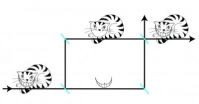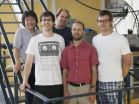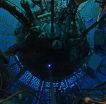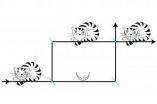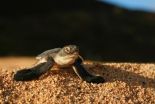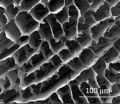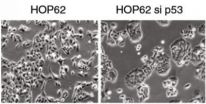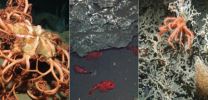(Press-News.org) Researchers from the Vienna University of Technology have performed the first separation of a particle from one of its properties. The study, carried out at the Institute Laue-Langevin (ILL) and published in Nature Communications, showed that in an interferometer a neutron's magnetic moment could be measured independently of the neutron itself, thereby marking the first experimental observation of a new quantum paradox known as the 'Cheshire Cat'. The new technique, which can be applied to any property of any quantum object, could be used to remove disturbance and improve the resolution of high precision measurements.
The idea of a Quantum Cheshire Cat was proposed theoretically last year. It is based on the well known character from Alice in Wonderland who can vanish leaving his smile behind. In quantum physics, the term refers to an object whose properties can be separated from its physical location so that the two can be measured at different places. While this is clearly not possible in our everyday experience, where objects are spatially linked to their properties, the laws of Quantum Mechanics allow it to be achieved.
Quantum mechanics already tells us that particles can be in different physical states at the same time, a phenomenon known as superposition. For example if a neutron beam is divided in two using a crystal, individual neutrons do not have to decide which of the two paths to take. Instead, they can travel along both paths at the same time in a quantum superposition.
"This experimental technique is called neutron interferometry", says Professor Yuji Hasegawa from the Vienna University of Technology. "It was invented here at the Atominstitut in the 1970s, and it has turned out to be the perfect tool to investigate the foundations of quantum mechanics."
To see if the same technique could separate the properties of a particle from the particle itself, Yuji Hasegawa brought together a team including colleagues Tobis Denkmayr, Hermann Geppert and Stephan Sponar from Vienna, together with Alexandre Matzkin from CNRS in France, Professor Jeff Tollaksen from Chapman University in California, and Hartmut Lemmel from the Institut Laue-Langevin to develop a brand new quantum experiment.
Their aim was to get neutrons at the ILL to travel along a different path from its magnetic moment - a property describing the particle's coupling strength to an external magnetic field. The neutron's magnetic moment has a directional preference, a property called spin. In the experiment the neutron beam was split into two paths with different spin directions. The upper beam path had a spin parallel to the neutrons' direction of flight whilst the spin of the lower beam pointed in the opposite direction.
After the two beams were recombined the experimental detector was set up so that only neutrons with spin parallel to the direction of motion - implying that those travelling along the upper path - are detected. "This is called postselection", says Hermann Geppert. "The beam contains neutrons of both spin directions, but we only detect a selection of the neutrons."
The team then introduced a filter, which absorbs some of the neutrons, in the lower beam path. This did not change the number of detected particles. However, when the very same filter was introduced in the upper beam path, the number of detected neutrons was reduced.
Things get tricky, when the location of the neutron spin is measured: the spin can be slightly changed using a magnetic field. When the two beams are recombined appropriately, they can amplify or cancel each other. This is exactly what can be seen in the measurement, if the magnetic field is applied at the lower beam – but that is the path, which the neutrons are actually never supposed to take. A magnetic field applied to the upper beam, on the other hand, does not have any effect.
"By preparing the neutrons in a special initial state and then postselecting them, we can achieve a situation in which both possible paths in the interferometer are important for the experiment, but in very different ways", says Tobias Denkmayr. "Along one of the paths, only an interaction with the particles themselves has an effect, but the other path is only sensitive to a magnetic spin coupling. The system behaves as if the particles were spatially separated from their properties."
The success of this unique type of quantum experiment was dependent on making so called 'weak measurements' to avoid the collapse of the superposition in accordance with the laws of quantum mechanics.
"These weak measurements give you less information," explains Hartmut Lemmel, instrument leader on S18, the ILL's crystal thermal neutron interferometer on which the Cheshire Cat was observed. "As a result you need to do lots of observations to achieve any sort of certainty that you have seen what you think you have seen. This was only possible due the strength of the neutron source available at the ILL which can uniquely provide the numbers of neutrons required to run these repeat experiments."
With their landmark observation suitably vindicated, questions turn to the potential impact of their fundamental discovery. One application might high precision measurements of quantum systems which are often affected by disturbance.
"Consider a quantum system that has two properties: you want to measure the first one very precisely but the second makes the system prone to perturbations. The two can be separated using a Quantum Cheshire Cat, and possibly the perturbation can be minimized", says Stephan Sponar.
INFORMATION:
Scientists separate a particle from its properties
2014-07-29
ELSE PRESS RELEASES FROM THIS DATE:
The quantum Cheshire cat: Scientists separate a particle from its properties
2014-07-29
The Quantum Cheshire Cat: Can a particle be separated from its properties? On July 29, the prestigious journal, Nature Communications, published the results of the first Cheshire Cat experiment, separating a neutron from its magnetic field, conducted by Chapman University in Orange, CA, and Vienna University of Technology.
Chesire Cat"Well! I've often seen a cat without a grin," thought Alice in Wonderland, "but a grin without a cat! It's the most curious thing I ever saw in my life!" Alice's surprise stems from her experience that an object and its property cannot exist ...
The quantum Cheshire cat
2014-07-29
The Cheshire Cat featured in Lewis Caroll's novel "Alice in Wonderland" is a remarkable creature: it disappears, leaving its grin behind. Can an object be separated from its properties? It is possible in the quantum world. In an experiment, neutrons travel along a different path than one of their properties – their magnetic moment. This "Quantum Cheshire Cat" could be used to make high precision measurements less sensitive to external perturbations.
At Different Places at Once
According to the law of quantum physics, particles can be in different physical states at ...
Major turtle nesting beaches protected in 1 of the UK's far flung overseas territories
2014-07-29
But on the remote UK overseas territory of Ascension Island, one of the world's largest green turtle populations is undergoing something of a renaissance.
Writing in the journal Biodiversity and Conservation, scientists from the University of Exeter and Ascension Island Government Conservation Department report that the number of green turtles nesting at the remote South Atlantic outpost has increased by more than 500 per cent since records began in the 1970s. As many as 24,000 nests are now estimated to be laid on the Island's main beaches every year, making it the second ...
Could summer camp be the key to world peace?
2014-07-29
According to findings from a new study by University of Chicago Booth School of Business Professor Jane Risen, and Chicago Booth doctoral student Juliana Schroeder, it may at least be a start.
Risen and Schroeder conducted research on Seeds of Peace, one of the largest peacebuilding programs that brings together teenagers from conflict regions, including Israelis and Palestinians, every year for three weeks in rural Maine. They tracked participants' feelings and attitudes toward the other national group for three years with three separate cohorts of campers. They found ...
Tough foam from tiny sheets
2014-07-29
HOUSTON – (July 29, 2014) – Tough, ultralight foam of atom-thick sheets can be made to any size and shape through a chemical process invented at Rice University.
In microscopic images, the foam dubbed "GO-0.5BN" looks like a nanoscale building, with floors and walls that reinforce each other. The structure consists of a pair of two-dimensional materials: floors and walls of graphene oxide that self-assemble with the assistance of hexagonal boron nitride platelets.
The researchers say the foam could find use in structural components, as supercapacitor and battery electrodes ...
Research may explain how foremost anticancer 'guardian' protein learned to switch sides
2014-07-29
Cold Spring Harbor, NY -- Researchers at Cold Spring Harbor Laboratory (CSHL) have discovered a new function of the body's most important tumor-suppressing protein. Called p53, this protein has been called "the guardian of the genome." It normally comes to the fore when healthy cells sense damage to their DNA caused by stress, such as exposure to toxic chemicals or intense exposure to the sun's UV rays. If the damage is severe, p53 can cause a cell to commit preprogrammed cell-death, or apoptosis. Mutant versions of p53 that no longer perform this vital function, on the ...
Study: Pediatric preventive care guidelines need retooling for computerized format
2014-07-29
INDIANAPOLIS -- With the increasing use of electronic medical records and health information exchange, there is a growing demand for a computerized version of the preventive care guidelines pediatricians use across the United States. In a new study, researchers from the Indiana University School of Medicine and the Regenstrief Institute report that substantial work lies ahead to convert the American Academy of Pediatrics' Bright Future's guidelines into computerized prompts for physicians, but the payoff has the potential to significantly benefit patients from birth to ...
Menu secrets that can make you slim by design
2014-07-29
If you've ever ordered the wrong food at a restaurant, don't blame yourself; blame the menu. What you order may have less to do with what you want and more to do with a menu's layout and descriptions.
After analyzing 217 menus and the selections of over 300 diners, the Cornell study published this month in the International Journal of Hospitality Management showed that when it comes to what you order for dinner, two things matter most: what you see on the menu and how you imagine it will taste.
First, any food item that attracts attention (with bold, hightlighted or ...
From 'Finding Nemo' to minerals -- what riches lie in the deep sea?
2014-07-29
As fishing and the harvesting of metals, gas and oil have expanded deeper and deeper into the ocean, scientists are drawing attention to the services provided by the deep sea, the world's largest environment. "This is the time to discuss deep-sea stewardship before exploitation is too much farther underway," says lead-author Andrew Thurber. In a review published today in Biogeosciences, a journal of the European Geosciences Union (EGU), Thurber and colleagues summarise what this habitat provides to humans, and emphasise the need to protect it.
"The deep sea realm is so ...
Genomic analysis of prostate cancer indicates best course of action after surgery
2014-07-29
(PHILADELPHIA) – There is controversy over how best to treat patients after they've undergone surgery for prostate cancer. Does one wait until the cancer comes back or provide men with additional radiation therapy to prevent cancer recurrence? Now, a new study from Thomas Jefferson University shows that a genomic tool can help doctors and patients make a more informed decision.
"We are moving away from treating everyone the same," says first author Robert Den, M.D., Assistant Professor of Radiation Oncology and Cancer Biology at Thomas Jefferson University. "Genomic ...
